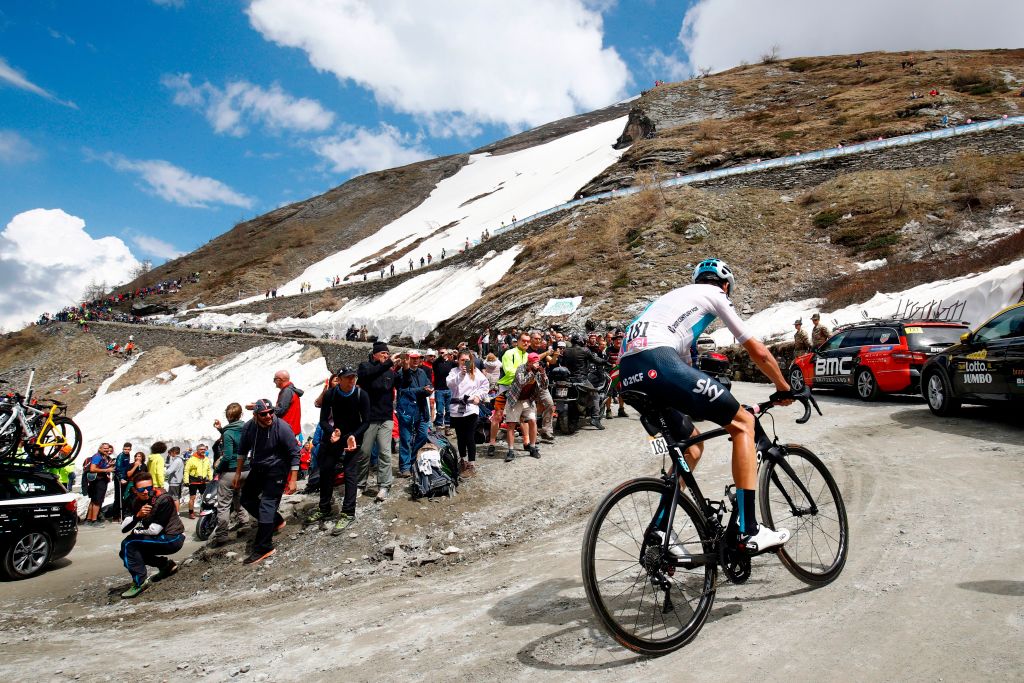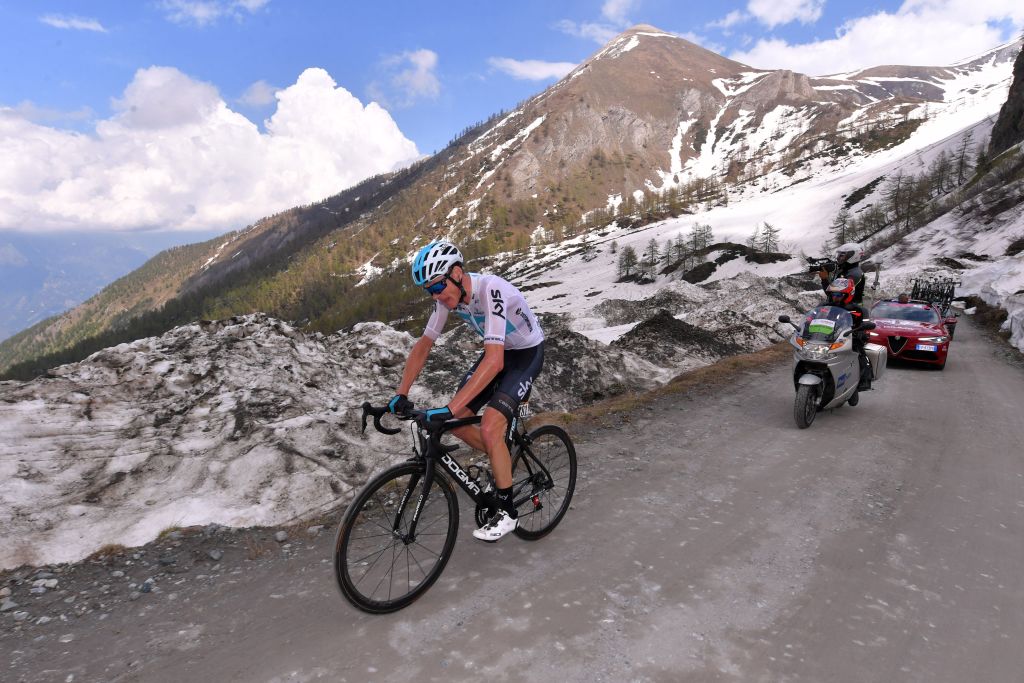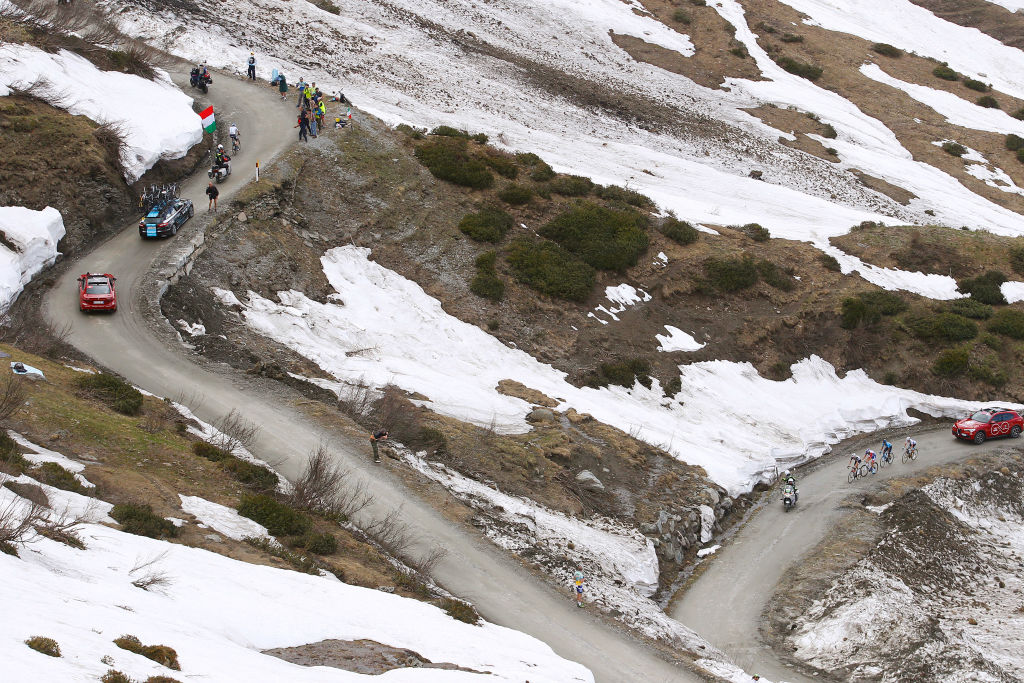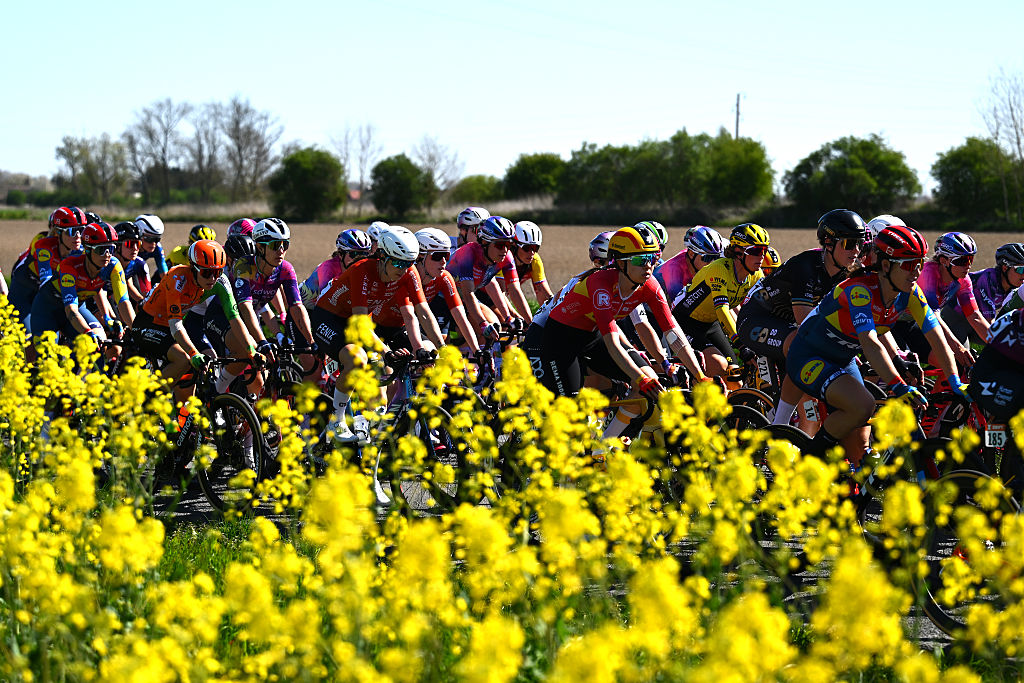Snow, gravel and a Chris Froome epic – The Colle delle Finestre is the modern legend of the Giro d'Italia
Looking back on one of the most memorable stages in Giro history, and why this climb is already an icon of the race

When we think about the iconic climbs of the Giro d'Italia, we tend to think of those that have been a long part of the race's history, introduced fifty, sixty, or seventy years ago. The Passo dello Stelvio, the Gavia, the Passo Giau. Even the more modern additions – like the Mortirolo – date back to the first inclusions in the 1990s.
But amongst the list of the Corsa Rosa's defining climbs, there is one that hasn't needed much time at all to already build a mythical status. The Colle delle Finestre only appeared in the Giro d'Italia for the first time in 2005, but, as it returns to the 2025 race route, it is already a site of legend.
Even on that first day, twenty years ago, it was clear almost immediately that the climb would become an icon of the Giro, such were its stinging gradients and nasty unpaved roads. The list of names who have crested the Finestre first in the Giro is short and selective – Danilo Di Luca in 2005, Vasil Kiryienka in 2011, Mikel Landa in 2015 and Chris Froome in 2018 – and whilst only Kiriyienka and Froome would win the respective stages, just winning that KoM point is a badge of honour.
When the peloton returns to the Colle delle Finestre on stage 20 of this year's Giro, it will be the climb's fifth appearance in two decades, and again it will be site of the race's Cima Coppi, awarded at the highest point, as the riders crest 2,178m on the way to Sestriere.
The Colle delle Finestre is not just any long, high Grand Tour climb, however – it's a real beast. Taking the route from Susa, as the Giro has always done, the climb is 18.6km long, with an average gradient of a taxing 9.1% – notably high for a climb of that length – and with many pitches well above that, the steepest at 14%. The road is also packed with hairpins, constantly twisting and turning its way to the top.
If that wasn't hard enough already, with 8km to go to the top, the road turns to gravel. Not fun, flat gravel, but the gravel of a road so unused and difficult to pass that it never needed to be paved, and full of ruts and rough patches, all uphill. Gravel climbs like this have become a trend in Grand Tours, think the Planche des Belles Filles in the Tour de France, but the Finestre is far from a trendy climb, it's a brute, forcing riders to tackle leg-sapping gravel on an already grim climb.
Coming on the final day of 'real' racing before the procession day into Rome, the Finestre stage in this year's Giro will cap off a tough last week of climbing, and offer up the very last opportunity to shake up the GC. As long as snowfall doesn't prevent the race from getting up there, the Finestre will be decisive, and the excitement is high after seven years of absence for this iconic ascent.
The latest race content, interviews, features, reviews and expert buying guides, direct to your inbox!
What is it that makes this climb so special, though? Part of it is the climb's characteristics, but much of the anticipation comes from what happened the last time the Giro visited the Finestre – one of the greatest and most memorable rides in recent history.
Chris Froome's Finestre raid

On the morning of May 25, 2018, the peloton was preparing for the 19th stage of the Giro d'Italia, a 184km day from Venaria Reale to Bardonecchia, with the Colle dell Finestre in the middle. Simon Yates was in the race lead, 28 seconds clear of the defending Giro champion Tom Dumoulin, and the last two days of the race looked like they would be a two-horse battle, with third place Domenico Pozzovivo 2:43 back.
Teams, fans and journalists alike were so busy thinking about who might prevail out of Yates and Dumoulin on the Finestre – the small pure climber or the steady engine – that barely a thought was paid to Chris Froome that morning, 3:44 back in fourth after struggling with a crash on the first day, and surely out of the race.
Five hours and 12 minutes later, however, Froome had turned the race on its head, and in many ways, reinvented racing as we now know it. Not content with settling for fourth, Froome did something that at the time was practically unheard of, and he attacked 80km away from the finish, on the Colle delle Finestre, in what would turn into a huge and memorable solo ride.
On the tough gravel, his rivals initially couldn't close the gap to Froome, but may have expected that they could bring him back on the next climb, back on tarmac. But instead, Froome stayed away for 80 kilometres, gaining over three minutes on the rest of the GC contenders, and putting himself into a race lead that he would take to Rome, winning his first Giro d'Italia.
"It was probably the most memorable day on the bike for me," Froome recently told Cyclingnews. "In terms of the victories I've had in my career, it really was the most memorable when I look back."
Often labelled as being a particularly controlled, perhaps conservative rider, Froome has since described that day as a chance he got to show his true personality on the bike, his real racing spirit. Even when he thought up the idea – a decision made on the morning of the stage – his own team were not sure it was achievable.
"I sent a message to my coach, Tim Kerrison, and just said to him, 'It's a bit of a crazy move, but what if I went 80ks out?'" Froome explained in a 2019 video with Science in Sport, released to mark the one-year anniversary of the day so important it warranted an anniversary.
"He replied, and his reply was a little bit along the lines of… He didn't say no, but he said, 'Listen, it would take a lot of work to do something like that'."
But work they did, and in fact, what Froome and Team Sky did that day would alter our understanding of race physiology for a long time.
The key to the solo move: fuelling
Froome has been open, both at the time and since, that is what made the difference and made that win on the Finestre possible was fueling. The grim, gravel climb was the launchpad for the move, and an intense feeding strategy was what made it possible to stay away.
"Fuelling was a big part of that day for me, and I think that's one thing that's just changed even more now since then," he explained. "We've really started paying a lot more attention to fuelling to allow for those kind of performances."
Froome was feeding constantly, with Team Sky deploying as many staff members as possible on the road to hand up gels and carbohydrate drinks, with six people stationed on the Finestre alone.
Data released by Team Sky after the fact showed that Froome planned to take on 14 gels and two bottles of Science in Sport Beta Fuel, for a total of 502g of carbs during the race, or 96g per hour. At the time, that was a lot compared to a normal day, but now in an era where riders will regularly aim for 120g per hour or more, it's easy to see just how things have changed and progressed.
As Cyclingnews spoke to Froome at the Tour of the Alps, there was some irony in reflecting on that 80km move as something outlandish. His current Israel-Premier Tech teammate Marco Frigo had just the day before won with a solo move of a similar length, and hours after speaking to Froome, Ineos Grenadiers' Thymen Arensman would also ride solo for 80km to grab the lead of the race, unsurprisingly referencing his high carb intake as a reason why that was possible.
It's a change Froome is more than aware of, and extremely different from even a few years ago when he used to dominate the biggest stage races. If you only started watching cycling in the last four or five years, it may be difficult to understand quite how rare such a huge move was back then.
"Attacking so far out, now it's become a lot more common in the peloton, I mean Frigo did it yesterday," Froome said. "And watching the Classics even, in almost every race, guys are attacking further and further from the finish, but back then it just wasn't something that we saw from GC riders.
"Maybe it was the start of something," he said of that fateful day on the Finestre.
Whilst we may think that riders like Tadej Pogačar, Mathieu van der Poel or Remco Evenepoel just have more vim, vigour and racing spark and that's why they attack from so early on – and Froome himself conceded to Cyclingnews that he's simply not a rider like these modern racers – but they don't win on brave attacks alone. Why they're able to succeed is down to a much more meticulous way of taking on and using energy, and that's something that Froome's Finestre win undeniably accelerated.
The Finestre in 2025

Despite the increased frequency and capability for long-range attacks in the peloton, it remains relatively rare to see huge, final-week attacks like Froome's, ones that turn Grand Tours upside down, but the inclusion of the Colle delle Finestre in the final week of the Giro could change that.
The Giro is built a little differently this year, with fewer mountaintop finishes than usual and more medium, attack-friendly days, so the huge day to Sestriere on the final Friday should represent a big opportunity.
"The third week of the Giro is definitely a lot more heavily loaded in terms of climbs, but I think a day like that really is one of the stand-out stages of the Giro," was Froome's assessment of the climb's inclusion in the 2025 route. "There's nowhere to hide, and I think teams will really put it all on the line to go for the win."
More so than a mid-race Stelvio, or a final-week Passo di Giau, the exceptionally tough Colle delle Finestre simply offers more opportunities for unpredictability, with the gravel and the hairpins making this much more complicated than 'just' a big, long climb. Froome's audacious win may have been largely a physiological triumph, but there's a reason why it was the Finestre that launched the move and not just any other climb, and that's because it's a beast in nature that is open to the unexpected.
The only sticking point is that, at the time of writing, there are concerns about whether the Finestre will actually be passable, due to heavy snowfall in the area. Stage 19 is still some four weeks away, but that's not an overly long time for the snow to clear.
In some ways, being under the threat of the weather only helps the Finestre's cause in establishing itself as a legendary climb, as it now shares that with the Stelvio and the Gavia, both often proved impassable by snow.
Gruelling terrain, threats of snow and a race so iconic it's still remembered, recalled and discussed years later – the Colle delle Finestre really does have all the ingredients of an iconic Grand Tour climb, even if it's only been part of the Giro for twenty years.
Chris Froome may not be in the Giro peloton tackling the climb this year, and an 80km solo move may not be as outlandish as it was back then, but the Brit will always be part of this climb's history, and what makes it so legendary. And if weather allows, a new story will write itself into the Finestre mythology this May.
Subscribe to Cyclingnews for unlimited access to our 2025 Giro d'Italia coverage. Our team on the ground will bring you all the breaking news, reports, analysis and more from every stage of the Italian Grand Tour. Find out more.
Matilda is an NCTJ-qualified journalist based in the UK who joined Cyclingnews in March 2025. Prior to that, she worked as the Racing News Editor at GCN, and extensively as a freelancer contributing to Cyclingnews, Cycling Weekly, Velo, Rouleur, Escape Collective, Red Bull and more. She has reported from many of the biggest events on the calendar, including the Giro d'Italia, Tour de France Femmes, Tour of Flanders and Paris-Roubaix. She has particular experience and expertise in women's cycling, and women's sport in general. She is a graduate of modern languages and sports journalism.
You must confirm your public display name before commenting
Please logout and then login again, you will then be prompted to enter your display name.
